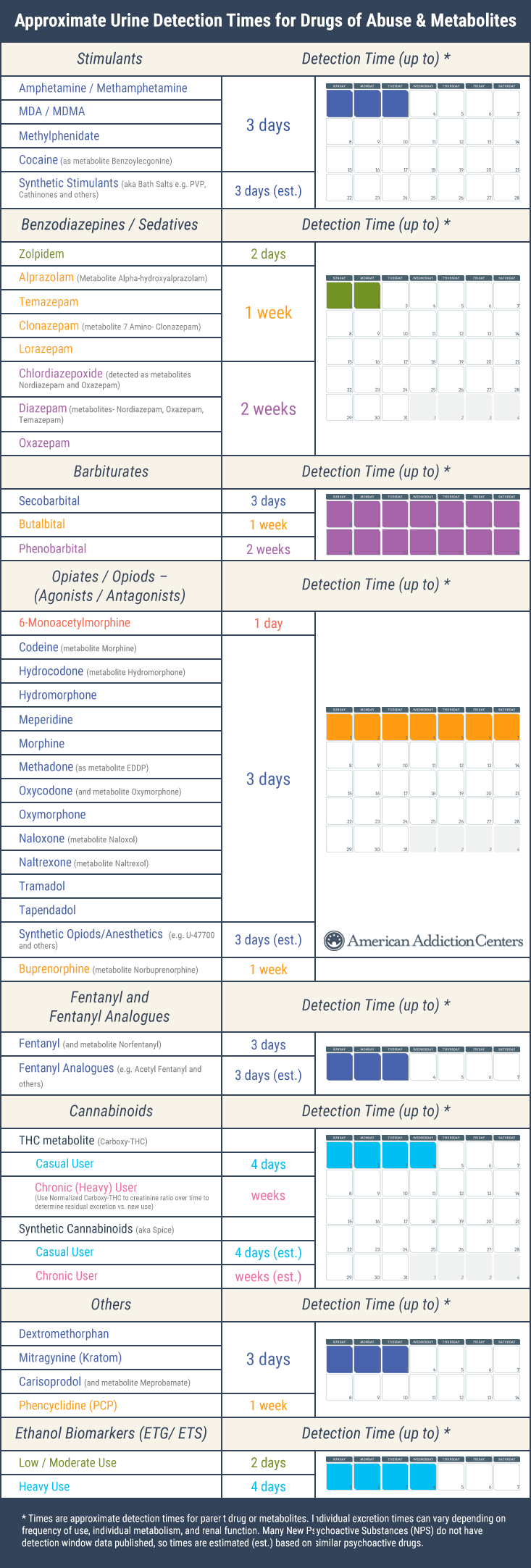How Long Do Drugs Stay In Your System? (Drug Half-Life & Drug Tests)
The exact amount of time a drug stays in the body will vary according to factors like the dose, the person’s age, weight, and sex, and their physical health.
However, according to the U.S. Food and Drug Administration, some average times that drugs will continue to show up in a urine drug test include the following:1
- Heroin: 1-3 days.
- Cocaine: 2-3 days.
- Marijuana/THC: 1-7 days.
- Meth: 2-3 days.
- MDMA: 2-4 days.
There is no way to completely predict just how long a drug will take to be eliminated from your body. The only way to know you’ll pass a drug test is to abstain from drugs.
A common question among people who use drugs—whether illicitly or by prescription—is, “How long will this drug stay in my body?” This question may be asked by those looking to understand how long the drug’s effects will last, when to expect the beginning of withdrawal, or whether they can pass a drug test, but the fact is that this answer is rarely clear and can be highly variable among individuals.
How Long Will a Drug Stay in My Body?
Drugs are a general term used to describe a variety of foreign substances that may be taken to induce some kind of effect. Drugs may be illegal/illicit or prescription. Even everyday household products like cleaning supplies and gasoline may be considered drugs when abused for psychoactive effects.1
As large as the variety of drugs, so is the variation in the duration of actions of these drugs in the body. Each drug will last in the body for a different amount of time after it is consumed.1
The variation does not end there, though. The time it takes for the body to eliminate a drug from the system depends on many factors beyond just the specific drug type, including:2
- The dose.
- Presence of other drugs in the body.
- Age.
- Ethnicity
- Sex.
- Weight.
- Incidence of medical conditions affecting drug elimination, like kidney problems.
Because of these factors, two people using the same substance could have a very different experience. A drug like Xanax, for example, is influenced by the age, health, and ethnicity of the person, with the drug lasting longer in people who are obese, older than 64, have liver problems, or are Asian or white.2
The above individual differences can influence the way the body metabolizes and eliminates the drug, so people of similar weight, sex, and ethnicity are more likely to metabolize drugs similarly. In general, once a drug is consumed, the body begins to metabolize it by breaking apart the molecule or otherwise chemically changing the ingested substance to facilitate the process of ultimately clearing it from the body.3
Some substances, like alcohol, require multiple steps from several enzymes to be completely metabolized. Alcohol is broken down into acetaldehyde, a toxic, cancer-causing substance, then acetate, and finally separated into water and carbon dioxide for easy removal from the body.3
Regarding our ability to metabolize and clear substances from the body, variations amongst individuals are difficult to isolate and adjust for. It is therefore difficult to precisely determine how long a drug will stay in the body or how long a drug will available for detection in a test, although there are some general guidelines.
For those worried and concerned about a drug being detectable in their body, it’s essential to understand that the only way to ensure a negative test is not to use drugs.
What Is a Drug’s Half-Life?
When learning about drugs of abuse and their duration of action, one term is frequently encountered: half-life. A drug’s half-life—sometimes called elimination half-life—represents how long it takes for a drug’s concentration in the body to drop by 50%.2
Each substance has a unique half-life determined by the balance of metabolism and excretion rates.2 Again, these half-lives are average durations that can be greatly impacted by a number of individual factors.
In terms of substance abuse, the drug’s half-life helps to determine how long the effects will last in the body but has little to do with the speed of onset (when the effects will be felt).4
Benzodiazepines are a good example of the distinctions between speed of onset and half-life, since they are a large group of chemically-similar drugs often sub-classified by their widely variable onsets of effects and durations of action. With these drugs, long-acting variations with long half-lives can have a rapid or intermediate onset of action and short-acting versions can also have rapid or intermediate onset of action.5 Changing the route of administration—injecting rather than swallowing a version with an intermediate onset of action—may speed up onset, but it will not change the half-life.5
Since drugs with long half-lives stay in the body longer, they will be detectable for a longer period with a drug screen.2 This means a benzodiazepine with a long-half-life like Valium may, on average, be detectable longer than a drug with short half-life like Xanax.5
A drug’s half-life may also be used to roughly predict the timeline for the emergence of withdrawal symptoms when use ends. Withdrawals represent a number of unwanted and uncomfortable symptoms triggered by the drug leaving the body.6 Drugs with short half-lives like heroin will trigger withdrawal symptoms sooner than drugs with long half-lives with methadone.6
List of Drug Half-Lives
The half-lives of some of the most widely used illicit drugs are:
- Heroin: Between 2 and 6 minutes.6
- Cocaine: 1 hour.7
- Marijuana/THC: Between 4 and 6 days.8
- Methamphetamine: About 11 hours.9
- MDMA: Around 8 hours.10
Half-lives of some of those most widely used (and abused) prescription drugs are:2
- Stimulant drugs routinely prescribed for attention-deficit/hyperactivity disorder (ADHD):
- Amphetamine, a primary component of Adderall – Between 7 and 34 hours depending on urine pH level.
- Methylphenidate (Ritalin, Concerta) – 2 or 3 hours for children and between 2 and 5 hours for adults.
- Opioid painkillers:
- Oxycodone: 3 to 5 hours.
- Morphine: 1 to 7 hours.
- Fentanyl: 3 to 12 hours.
- Benzodiazepines and other sedatives prescribed for anxiety/panic and sleep problems:
- Xanax: 6 to 16 hours for people 64 and younger and 9 to 27 hours for people 65 and older.
- Valium: 21 to 37 hours.
- Klonopin: 19 to 60 hours.
- Ambien: About 2 hours.11
How Long Are Drugs Detected in Urine?
When people wonder about drug half-lives, they are often concerned with how long a drug is measurable in the system because they are facing a drug test. A drug test is a tool that looks for the presence of specific substances (both legal and illicit) in the body.12
Drug tests commonly look for:12
- Marijuana.
- Opioids.
- Cocaine.
- Sedatives.
- Amphetamines/meth.
- Steroids.
Different situations require the use of drug tests. Drug tests are used for:12
- Employers often require drug tests, especially if job duties may result in serious injury if the employee is substance-impaired.
- Sports participation. High school, college, and professional athletes often undergo drug testing to confirm the absence of performance enhancing or other drugs to ensure safety and fair play.
- Legal purposes. People accused of crimes may be tested by law enforcement at the scene of the crime, shortly thereafter, or long-term as a part of their parole or probation.
- Monitoring therapeutic doses of medications. Doctors may order urine tests to make sure patients are taking the directed dose of their prescription, and no more.
Most drugs of abuse stay in the body for at least a few days after the last use and are traceable with urine tests.1
- Opioids like heroin and oxycodone are detectable for between 1 and 3 days after last use.
- Stimulants including cocaine, meth, and ADHD medications are detectable for about 2 or 3 days.
- Benzodiazepines and MDMA generally flag a urine test for up to 4 days after last dose.
- Marijuana stays in the system a bit longer, with amounts being detectable for between 1 and 7 days after last use.
- Barbiturates, another type of prescription sedative, will usually be detectable in urine for up to 3 weeks after last dose.
Disclaimer: Drug half-lives offer some good information about how long a drug stays in the body, but they aren’t perfect indicators of how long a drug can be detected in a test. You should not use these averages to try and trick a test. Also, drugs can be detected in blood and hair for longer than urine.
Our medical director, Dr. Calarco gives insight into whether every drug in your system shows up on a drug test in the video below.
@americanaddictioncenters Does every drug in your system show up on a drug test? #drugtest #druguse #addiction #realtalkrecovery #educational #learnontiktok ♬ Pieces (Solo Piano Version) – Danilo Stankovic
How to Pass a Drug Test
The only way to reliably pass a drug test is to abstain from drugs.
How Do People Try to Beat Drug Tests?
As long as there have been drug tests, there have been people trying to cheat the tests. They may go to great lengths to fool the tests or the person administering the test.
The methods used vary by the type of test being administered. For urine tests, people will try to:13
- Detoxify their urine. By drinking large amounts of water or cranberry juice, people think they can flush the drugs from the body and cleanse their urine. Numerous products are available to purchase online with the promise of detoxifying the urine as well. These drinks, capsules, and chewables claim to erase traces of drugs in as little as 1 hour.
- Use additive products to cleanse their urine. When unable to provide a drug-free urine sample, people will sometimes try adding chemicals to the urine sample to mask or eliminate the presence of drugs. Called additives, these liquids and solid crystals claim to be compact, discreet, and undetectable while offering “guaranteed” success.
- Substitute other urine for their own. People desperate to pass a drug test may try to pass off another person’s urine as their own. People may obtain urine from a friend or loved one and pour it into the sample cup to deceive the testers. Some available products are quite elaborate. Not only do they provide substituted urine, but they also provide wearable belts and tubes that have a realistic anatomical resemblance to make test cheating easier.
The options for trying to cheat drug tests are not limited to urine tests. For tests that sample saliva, there are a variety of gums, capsules, and mouthwashes that promise to yield clean tests.14 For tests that examine hairs, shampoos, conditioners, cleansing mud, and complete purification systems claim to result in a successful outcome.14
People attempting to outsmart drug tests are often disappointed in the end, though. Home and online remedies show little chance of success, and trying to dilute or manipulate the sample may be obvious to the tester or the specific test.13
Looking to the internet can be an expensive exercise in futility because most of these products do not live up to their claims of cleansing, detoxing, or fooling drug tests. Many of these products simply do not work at all.13 Not only do they not work, but they can be very costly.
Even in the rare case that such a product leads to a negative drug test, the product itself will likely be traceable in the urine sample.13 This finding would raise a red flag and lead to additional drug testing and attention in the coming days and weeks.
People have long tried to beat drug tests, but again, it’s impossible to know just when the drug will be out of the system because it’s so unpredictable. Though falsified test results may help you avoid immediate repercussions, you may be only be prolonging an underlying bad situation or delaying much-needed help should a substance use disorder or addiction be a factor. If you’re abusing drugs and you can’t stop, professional treatment is the best way forward.
Detection Time in Urine for Various Drugs

How to Detox the Body
 Stopping drug use is always the right choice, but how you quit could carry some risks. In some cases, sudden or “cold turkey” abstinence is not advisable. To be safe, meet with a doctor or addiction treatment professional so that you understand the potential risks of quitting certain substances, including alcohol.
Stopping drug use is always the right choice, but how you quit could carry some risks. In some cases, sudden or “cold turkey” abstinence is not advisable. To be safe, meet with a doctor or addiction treatment professional so that you understand the potential risks of quitting certain substances, including alcohol.
People who decide to end their drug use may experience withdrawal symptoms if their bodies have adapted to the drug’s presence (known as dependence).15 Many drugs are associated with distinct withdrawal syndromes—some may be managed with emotional support but others could require emergency medical intervention depending on symptom severity; just how severe withdrawal will be will be dependent on many factors including the drug type and the individual’s health.15
The term “detox” is often used casually to refer to clean eating, drinking water, fasting, and generally flushing “toxins” out of the system. For a very casual substance user who wants to feel healthy, a period of drinking a lot of water, eating well, and not using drugs may be enough for them to feel like they’ve detoxed their bodies. However, in the case of physical dependence on a substance, “detox” refers to the set of interventions used to manage the body’s readjustment to not having the drug; this readjustment is knowns as withdrawal, and it can be an extremely dangerous time, depending on the drug on which the person is dependent.
Dependence may develop quickly, depending on the patterns of use and the drug. Some people who’ve been using only for a matter of weeks may experience withdrawal upon quitting.15 Certain prescription drugs may also lead to significant dependence, and individuals abusing prescription drugs may be just as at-risk of withdrawal complications as a person using illicit substances.15
If you’ve been using one or more drugs consistently and want to quit, it’s a good idea to meet with a medical professional to gauge your risk of withdrawal and best determine the appropriate method for you to end your substance use. You may be advised to undergo medical detox if you are at risk of severe withdrawal, for example if you’re dependent on alcohol or benzodiazepines.15
Depending on the substance, severe symptoms could include:6
- Seizures.
- Severe confusion and disorientation.
- Hallucinations.
- Depression and anger resulting in self-harm or aggression toward others.
- Death.
When you meet with a medical or addiction professional to discuss the safest way to quit using one or more substances, they will gather information regarding:15
- Substances used.
- The intensity, frequency, and duration of use.
- Previous attempts at detox.
- Preexisting mental health conditions.
- Preexisting physical health conditions.
People at highest risk of severe, dangerous withdrawal will be referred to inpatient medical detox; these programs provide 24-hour care from an experienced team of medical staff.15 Inpatient detox normally occurs in acute care hospitals or standalone detox centers to ensure effective treatment with staff who are able to respond quickly to complications or emergencies.15
When appropriate, non-medical or socially managed detoxes are residential treatment options that provide supportive care and compassion from the staff to help people through withdrawal and encourage recovery.15 Though helpful for many, these detoxes may not provide sufficient support for someone dependent on opioids, alcohol, or sedatives.
Some people with relatively few acute health risks may be able to detox on an outpatient basis. Outpatient detoxes may offer similar medications and treatment plans to manage withdrawal while permitting the individual to live at home.15 For outpatient detox, the person will be required to keep regularly scheduled appointments with their doctors for evaluation and treatment.
Depending on the course of treatment, detox can take just a few days, several weeks or more. The decisions made during detox are aimed at making the withdrawal process as safe and comfortable as possible.15
Get Help for Drug Addiction
 Detoxification is a crucial step for anyone thinking about ending their substance use, but it is only one piece of the addiction treatment puzzle. In fact, since detoxification only targets the person’s physical dependence on substances, additional treatment is needed to address the psychological addiction.16
Detoxification is a crucial step for anyone thinking about ending their substance use, but it is only one piece of the addiction treatment puzzle. In fact, since detoxification only targets the person’s physical dependence on substances, additional treatment is needed to address the psychological addiction.16
If you’re living with addiction, worrying about drug tests, half-lives, and expensive products to detoxify your body will only waste your time and money and keep you living in the spiral of this disease.
Addiction is marked by a compulsion to get and use drugs.16 When addicted, drugs and alcohol push all important people and priorities to the background, which results in unwanted consequences like:6
- Continued use despite failing health.
- Increased conflict with friends and family.
- Inability to maintain employment and pay bills.
- Declining physical and mental health.
- Legal troubles including arrests, probation, and jail time.
Professional addiction treatment addresses all the factors that lead to and sustain addiction. With a combination of behavioral therapy and medication management, the person can begin to understand their addiction and triggers while beginning to restore their physical and mental health.16
Like detox, addiction treatment occurs in inpatient and outpatient settings. Inpatient/residential settings are good options for people who have severe addictions, limited supports at home, limited success with previous treatments while outpatient options are best for people with less intense addictions, more natural supports, and previous treatment success.16
Inpatient/residential treatments more closely resemble home-like settings than the hospital-like environment of medical detox. Outpatient treatments often occur in community health centers, doctors’ offices, or a dedicated rehab facility. Levels of outpatient treatment include:16
- Partial hospitalization programs (PHPs) that provide many hours of treatment each day, 5 days per week.
- Intensive outpatient programs (IOPs) that offer between 6 and 9 hours of treatment per week.
- Standard outpatient that may include as little as one hour of treatment per week.
Your treatment team will guide you in the most helpful direction based on your needs. Getting help for addictions does not begin and end with professional treatment, though. A number of support group options are available to complement and extend the benefits that one can get from professionals.16
Support groups like Alcoholics Anonymous (AA) and Narcotics Anonymous (NA) are organized and led by other people with a history of addiction.16 These groups create a sense of community and fellowship that aids the recovery process.
Addiction treatment can last for long periods of time, which may seem overwhelming, but since longer periods of treatment tend to result in longer periods of recovery, time in treatment is a worthwhile commitment.16
Remember, drugs stay in your system as long as you keep putting them there. Don’t fret about another drug test ever again; with treatment and diligent aftercare efforts, you can remain drug-free, sober, healthy from here on out.
Call an admissions navigator to learn more about treatment at an American Addiction Centers (AAC) facility or to verify your insurance and start your recovery journey today.
